The Children of the Night
– (Reading Time: 20 min Approx.)
NOTE TO READER: Read philosophically
RECAP: [Rose and her neighbors – the 1600 spirits of South Park Street Cemetery in Kolkata has a world of their own. They celebrate the Happy Death Day, as for them that is the day they came here. It was Rose’s Happy Death Day and they all were on a trip to the Botanical Garden..]
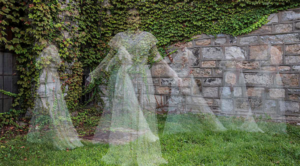
“What a pleasant night it is!” – Sister Elizabeth exclaimed.
3 a.m. walks are always pleasing to us. We don’t have to be bothered by humans then. Though Colonel Robert Kyd knew the way to Botanical Garden, Captain Cooke constantly kept looking at his compass, the entire way. He says – “When it’s about directions, I trust a compass more than men.”
He can be sarcastic sometimes. I overheard Sir Kyd saying to Sir Jones – “I will show this nincompoop who knows better about directions!”
Don’t worry; they do fight but it takes no time to become friends again. Ultimately, in the end, we only have each other.
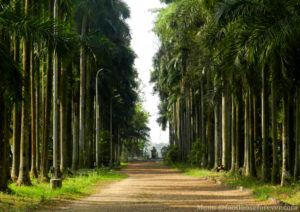
“We are now standing in front of the historical ground of ‘Indian Botanical Garden’. I, Colonel Thomas Kyd, will be your tour guide here. Honouring the Happy Death Day of Rose, I promise to take you all to a historical journey, which I have lived. And for that, I don’t need any directions.” – The colonel said the last line by ogling at Captain Cooke.
We all looked at the gate with wonder in our eyes. Colonel Kyd again said – “I would have suggested buying tickets before we entered but as there’s no one at the counter; let’s surpass now!”
Sister Elizabeth once told me that Colonel Kyd made a request in his will that he be buried without any religious ceremony in the botanical garden that he founded, but there was perhaps no one to pay heed to his last wishes and was instead buried in South Park Street Cemetery.

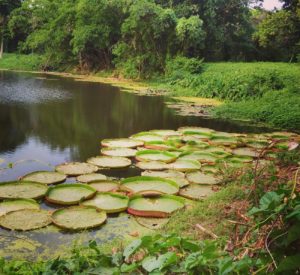
Colonel Kyd started telling us the mesmerizing history of Calcutta Botanic garden, later named Acharya Jagadish Chandra Bose Indian Botanic Garden, recently in the year 2009. The garden exhibits a wide variety of rare plants and a total collection of over 12,000 varieties are spread over 109 hectares. It is under the Botanical Survey of India (BSI) of the Ministry of Environment and Forests, Government of India.
“In the year 1786, when I was an army officer of the British East India Company; primarily to identify new plants of commercial value, such as teak, and growing spices for trade, I founded this enormous garden. Many people praised my initiative for introducing the tea-plant from China in Calcutta; this led to the establishment of the tea-trade in the Himalaya and Assam. A major change in policy, however, was introduced by the botanist William Roxburgh after he became superintendent of the garden in 1793. I still regret not being there as I died that year, but Roxburgh brought in plants from all over India and developed an extensive herbarium. This collection of dried plant specimens eventually became the Central National Herbarium of the Botanical Survey of India, which today comprises 2,500,000 items.” – we all can see the big smile on Colonel’s face as he went on with the glorious times of his life.
“Such a brag, Aye!” – Captain Cooke whispered to my ears. “Anyways the garden has been named after Jagadish Chandra Bose, the Bengali polymath, and natural scientist. I bet that he knew a lot more than your Colonel Kyd!” – Captain Cooke added.
It will be a lie if I deny that I don’t enjoy their little clash now and then. They make me feel alive sometimes. We were listening to Sir Kyd suddenly Sister Elizabeth shouted on little Henry – “Oh, Henry! Come down, you monkey boy!” We thought not to bring him with us but who can say no to a little kid. As we were busy talking, Henry ran away and started climbing the branches of a huge Banyan tree.
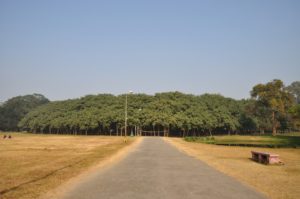
Colonel Kyd rushed under it and started scolding him. “You little fool! Do you have any idea how important this tree is!” Henry paid no attention to anyone and sat on a branch and started giggling.
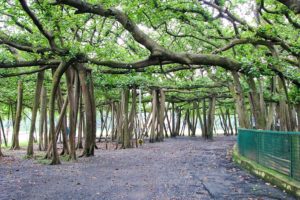
“Everyone! let me introduce you to The Great Banyan Tree. The Great Banyan tree is believed to be at least 250 years old and has been referenced in many travel books, going back to at least the nineteenth century. Early travel writers found it to be noteworthy due to its large size and its unusually high number of prop-trunks. It has survived two great cyclones in 1864 and 1867 when some of its main branches were broken. The present crown of the tree has a circumference of 486 m. and the highest branch rises to 24.5 m; it has at present 3772 aerial roots reaching down to the ground as a prop root. Its height is almost equivalent to The Gateway of India of Bombay (Mumbai).” – Kyd said.
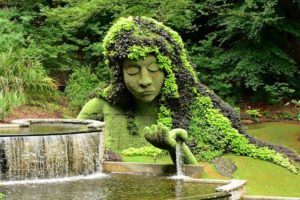
We roamed all over the garden. It is also famous for enormous collections of orchids, bamboos, palms, and plants of the screw pine genus (Pandanus). Animals seen inside the Botanic Garden include the Jackal, Indian mongoose, and the Indian Fox. Large numbers of varieties of snakes are also found in the garden. None of us are scared of them though.
During the 1770’s, the garden initiated a program to introduce improved food plants and other varieties of economic benefits to the people of India. Two years after that Calcutta became the capital of British India, a decision made by Governor-General Warren Hastings. Calcutta witnessed the establishment of the Supreme Court in 1774, making it the base of justice. It paved the path for the first English language weekly newspaper, Hicky’s Bengal Gazette or the Original Calcutta General Advertiser, in 1780.
Sir William Jones was quiet all this time. Hearing us talking about the Bengal Gazette he said – “Do you wish to know about that time?” We all looked at him that once. Colonel Kyd said – “Well, I don’t think anyone here can tell us about that better than you, Sir. I heard Mr. Hicky faced some issues from Warren Hastings’ wife Marian Hastings. You served the Supreme Court at that time. Please tell us what happened then!”
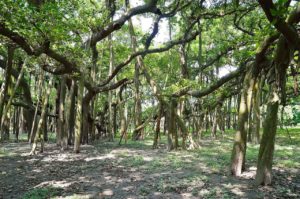
Sir Jones smiled and said – “Elizabeth tell Henry to come down. We will go to Victoria Memorial now. Sitting near the lake in this moonlight I will tell you quite an interesting story. And Charlotte, try not to take it personally.” – he started laughing saying this. We all joined him eventually.
“Have some sympathy for my nerves, you all scorners! I can never forgive that unfaithful man (Her partner Lawyer William Hickey) for forgetting me in a wink after my death. Never in my life, he said any sweet words to me but for that Indian girl, he couldn’t shut his foolish romantic heart! I despise him!” – Charlotte said angrily. If she was alive now, one could witness the red flush all over her cheeks.
Let me walk you through a bit about this intended pun. This is kind of a house joke for us. Charlotte joined us around the end of of 1782. She came to India with her former partner William Hickey. He was as an attorney-at-law, of James Hicky (Founder of Bengal Gazette). Upon arriving in India, Hickey was expected to join the British East India Company army as an officer cadet, but he refused the prospect when he learned that the pay was “…too contemptible to afford the common necessaries of life”. He got back from Plassey (from the famous battle with Siraj ud-Daulah, where Lord Clive defeated the nawab’s Army of 50,000 men with a meager 3,000 of East India Company Army) to return to England. Then he traveled first to China, of which he gives an account in his memoirs. His father was less than pleased at his return. After Hickey reverted to his old ways, his father sent him to Jamaica. He also returned prematurely from Jamaica.
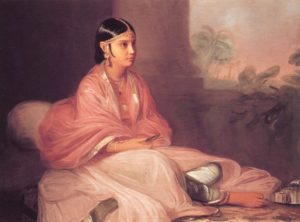
On his return, he took Charlotte Barry, with whom he fell in love. He offered to marry her, but she refused marriage. Later she agreed to live with him as his partner. The couple then traveled together to India when Hickey was 32 years old. Charlotte did not survive long, dying the year after they arrived.
Hickey established himself in the legal profession, managing to obtain a series of lucrative posts, including Under-Sheriff and Clerk to the Chief Justice. Some while after Charlotte’s death he took an Indian mistress, Jemdanee, who was local, considered to be his wife. After her death during childbirth, William Hickey wrote in his journal that – “Thus did I lose as gentle and affectionately attached a girl as ever a man was blessed with”. So, now you can guess the reasons for Charlotte’s rage over her ex-partner.
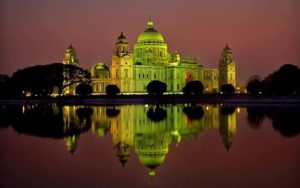
The night was flooding with moonlight. We sat in front of the water lake of Victoria Memorial Hall. When everyone seemed quite comfortable and we also found Henry asleep on Sister Elizabeth’s lap Sir Jones started with his story.
“Hicky began publication of Hicky’s Bengal Gazette on 29 January 1780, having first printed a prospectus announcing that he would begin printing a newspaper. The idea of printing a newspaper in India had been floated twelve years earlier by the Dutch Adventurer William Bolts, but Hicky was the first to execute the concept. Hicky’s newspaper was printed once a week on Saturday and retailed for rupees one. Its circulation was estimated to be around four hundred copies per week, although possibly more.
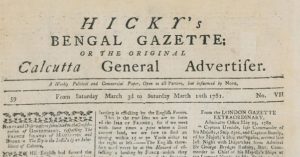
Hicky first maintained a neutral editing policy (his slogan was “Open to all Parties, but Influenced by None”) but after he learned that competitors with ties to the East India Company were intending to launch a rival newspaper, the India Gazette, he changed his editorial stance. Hicky accused an East India Company employee, Simeon Droz, of supporting the India Gazette as punishment for Hicky’s refusal to pay a bribe to Droz and Marian Hastings, Warren Hastings’ wife. In retaliation for Hicky’s accusation, Hastings’ Supreme Council forbid Hicky from mailing his newspaper through the post office. On November 18, 1780, the same day that the first India Gazette was published, Hicky modified the name of his newspaper from Calcutta General Advertiser to Hicky’s Bengal Gazette; or the Original Calcutta General Advertiser to emphasize that his newspaper was founded first. Hicky claimed Hastings’ order violated his right to free expression, and accused Hastings of corruption, tyranny, and even erectile dysfunction. (We couldn’t stop laughing.)
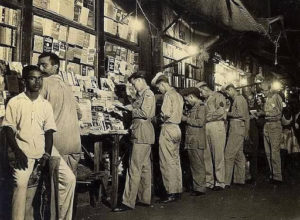
Hicky also accused other British leaders in Calcutta of corruption, including the Chief Justice of the Supreme Court of Judicature at Fort William, Elijah Impey of taking bribes, and the leader of the Protestant Mission, Johann Zacharias Kiernander of stealing from an orphaned children’s fund. Hicky’s editorial independence was short-lived as Hastings and Kiernander sued him for libel. After four dramatic trials in June 1781, the Supreme Court found Hicky guilty and sentenced him to jail.
Hicky continued to print his newspaper from jail and continued to accuse Hastings and others of corruption. He was finally suppressed when Hastings instituted fresh lawsuits against him. Hicky’s Bengal Gazette ceased publication on 30 March 1782 when its types were seized by an order of the Supreme Court. The next week, its types and printing press were publicly auctioned and sold to the India Gazette.”
“He was one tough lad, I must say!” – added Captain Cooke.
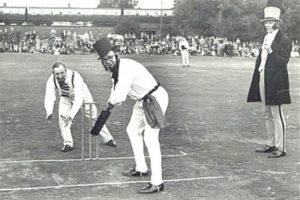
“In the time of British India, Calcutta was regarded as “The second city of the British Empire” (after London) and was aptly renamed “City of Palaces” and the Great Eastern Hotel was regarded as the “Jewel of the East”. Victoria Memorial can also be taken as an example of an exquisite architecture that was built between 1906 and 1921. Calcutta at that time was famous for its “Baboo (Rich Bengali) Culture”, a mixture of English Liberalism, European fin de siècle decadence, Mughal conservatism, and indigenous revivalism, inculcating aspects of socio-moral and political change.
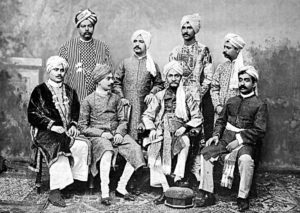
This culture was fostered in its wake by the Zamindari system, the Hindu Joint Family System. This also fostered the Bengal Renaissance, an awakening of modern liberal thinking in 19th century Bengal, and which gradually percolated to the rest of India.” – concluded Sir Jones.
“How about we take a tour of the Indian museum? Then we all can witness and hear the history side by side.” – Vivian asked.
Everyone got more excited now. I couldn’t believe my Death day celebration will take such an interesting turn. So far all I knew about Calcutta is from my aunt and uncle and some of my personal experiences. But the night is young, and death is only the beginning.
To be continued…
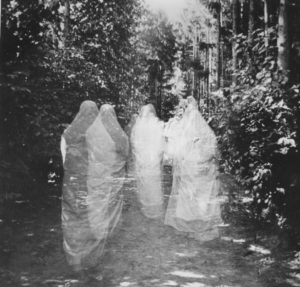

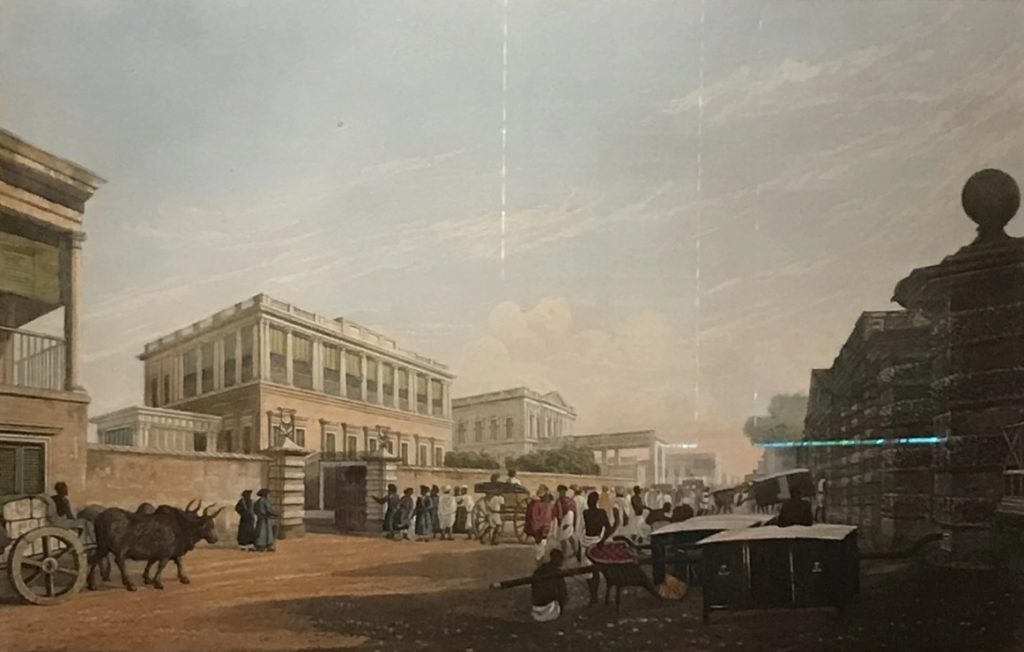
Surprisingly, I was at the Botanical and saw the various trees and also picked up a book on Hickeys Gazette from College Street not long ago. Also visited Indian Museum and its Rocks. Let us read about that next.